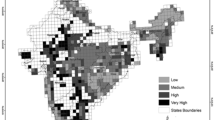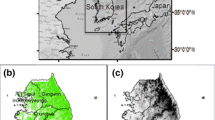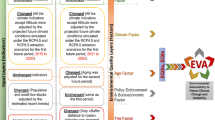Abstract
Climate change is a real, pressing and significant global problem. The concept of ‘climate change vulnerability’ helps us to better comprehend the cause/effect relationships behind climate change and its impact on human societies, socioeconomic sectors, and physiographical and ecological systems. In this study, multifactorial spatial modelling evaluated the vulnerability of a Mediterranean forest ecosystem to climate change and variability with regard to land degradation. This produced data and developed tools to support better decision-making and management. As a result, the geographical distribution of Environmental Vulnerability Areas (EVAs) of the forest ecosystem is the estimated Environmental Vulnerability Index (EVI) values. These revealed that, at current levels of environmental degradation, physical, geographical, policy enforcement, and socioeconomic conditions, the area with a “very low” degree of vulnerability covered mainly the town, its surrounding settlements and agricultural lands found principally over the low, flat travertine plateau and the plains to the east and southeast of the district. The spatial magnitude of the EVAs of the forest ecosystem under current environmental degradation was also determined. This revealed that the EVAs classed as “very low” accounted for 21% of the area of the forest ecosystem, those classed as “low” for 36%, those classed as “medium” for 20%, and those classed as “high” for 24%.










Similar content being viewed by others
References
Altan G, Türkeş M (2014) Hydroclimatologic characteristics of the forest fires in the Çanakkale district and relationship with climate variations. Ege Coğrafya Dergisi 20(2):1–25 (in Turkish)
Altan G, Türkeş M, Tatlı H (2011) Climatological and meteorological analysis of forest fires for the year 2009 in Çanakkale and Muğla with the Keetch-Byram Drought Index. In: 5th atmospheric science symposium proceedings, 27–29 April 2011: İstanbul, pp 263–274 (in Turkish)
Barbero M, Bonin G, Loisel R, Quézel P (1990) Changes and disturbances of forest ecosystems caused by human activities in the western part of the Mediterranean basin. Vegetation 87(2):151–173
Basso F, Bove E, Dumontet S, Ferrara A, Pisante M, Quaranta G, Taberner M (2000) Evaluating environmental sensitivity at the basin scale through the use of GIS and remotely sensed data: an example: covering the agriculture basin Southern Italy. CATENA 40:19–35
Camuffo D, Bertolin C, Diodato N, Barriendos M, Castro F, Cocheo C, Valle A, Garnier E, Alcoforado M (2010) The western Mediterranean climate: how will it respond to global warming? Clim Change 100(1):137–142
Cetin M, Musaoglu N, Tanık A (2008) Multi-temporal assessment of land-use change in a rapidly urbanizing coastal region in Turkey using remote sensing. Environ Eng Sci 25(6):917–928
Chen X, Yang D, Chen J, Xin C (2015) An improved automated land cover updating approach by integrating with downscaled NDVI time series data. Remote Sens Lett 6(1):29–38
Congalton RG, Green K (2008) Assessing the accuracy of remotely sensed data: principles and practices. CRC Press, Boca Raton, p 200
Desclee B, Bogaert P, Defourny P (2006) Forest change detection by statistical object based methods. Remote Sens Environ 102:1–11
DIS4ME (2014) Desertification indicators system for Mediterranean Europe. http://www.kcl.ac.uk/projects/desertlinks/indicator_system/esi_jan_05/method.htm. Accessed 15 April 2014
Emberger L (1930) Sur une formule climatique applicable en geographic botanique. Comptes Rendus Hebdomadaires des Séances. Academie des Sciences Paris 191:389–391
Emberger L (1932) Sur une Formule Climatique et Ses Applications en Botanique (On a climatic formula and its application in Botany). La Météorologie 192–193:423–432
Erol A, Randhir TO (2012) Climatic change impacts on the ecohydrology of Mediterranean watersheds. Clim Change 114(2):319–341
FAO, JRC (2012) Global forest land-use change 1990–2005. In: Lindquist EJ, D’Annunzio R, Gerrand A, MacDicken K, Achard F, Beuchle R, Brink A, Eva HD, Mayaux P, San-Miguel-Ayanz J, Stibig H-J (eds) FAO Forestry Paper No. 169. Food and Agriculture Organization of the United Nations and European Commission Joint Research Centre. Rome, FAO
Ferrarsa A, Bellotti A, Faretta S, Mancino G, Taberner M (1999) Identification and assessment of environmentally sensitive areas by remote sensing. MEDALUS III 2.6.2. OU Final Report. King’s College, London. 2:397–429
GDF (2012) Forest inventory results—2012. Forest Management and Planning Department Publication No: 86, Inventory Series No:13, Ankara 2012
Giri CP (2012) Remote sensing of land use and land cover: principles and applications. In: Weng Q (ed) CRC Press, Boca Raton
GIZ (2013) Guide méthodologique: Approche spatiale multifactorielle d’analyse de la vulnérabilité des écosystèmes face au changement climatique Cas de la subéraie en Tunisie. Deutsche Gesellschaft für Internationale Zusammenarbeit (GIZ)—GmbH; Ministère fédéral allemand de la Coopération Economique et du Développement (BMZ) and Appui à la mise en oeuvre de la Convention Cadre des Nations Unies sur le Changement Climatique (CCNUCC) en Tunisie, Tunisia
Glantz MH (1987) Drought, famine and the seasons in sub-saharan Africa. Afr Food Syst Crisis, Part 1 I:217–232
Gritti ES, Smith B, Sykes MT (2006) Vulnerability of Mediterranean Basin ecosystems to climate change and invasion by exotic plant species. J Biogeogr 33(1):145–157
Herold M, Mayaux P, Woodcock CE, Baccini A, Schmullis C (2008) Some challenges in global land cover mapping: an assessment of agreement and accuracy in existing 1 km datasets. RS of Environ 112:2538–2556
IPCC (2007) Climate change 2007: impacts, adaptation, and vulnerability. Part A: global and sectoral aspects. Contribution of working group II to the fourth assessment report of the intergovernmental panel on climate change, Cambridge University Press: Cambridge
IPCC (2014) Climate change 2014: impacts, adaptation, and vulnerability. Part A: global and sectoral aspects. Contribution of working group II to the fifth assessment report of the intergovernmental panel on climate change, Cambridge University Press: Cambridge
Keles S, Kadiogullari AI, Baskent EZ (2012) The effects of land-use and land-cover changes on carbon storage in forest timber biomass: a case study in Torul, Turkey. J Land Use Sci 7(2):125–133
Kosmas C, Ferrara A, Briassouli H, Imeson A (1999a) Methodology for mapping environmentally sensitive areas to desertification. In The Medalus project Mediterranean desertification and land use. Manual on key indicators of desertification and mapping environmentally sensitive areas to desertification. E.U 18882. pp 31–47 ISBN 92-828-6349-2
Kosmas C, Kirkby M, Geeson N (1999b) Manual on: key indicators of desertification and mapping environmentally sensitive areas to desertification. Energy, environment and sustainable development, EUR. European Commission, Brussels, p 18882
Kosmas C, Poesen J, Briasouli H (1999c) Key indicators of desertification at the ESAa scale. In: Manual on key indicators of desertification and mapping ESAs to desertification. MEDALUS III Project. King’s College, London
Lanquaye CO, Mitchell SJ (2005) Portability of stand-level empirical windthrow risk models. For Ecol Manage 216:134–148
Lelieveld J, Hadjinicolaou P, Kostopoulou E, Chenoweth J, El Maayar M, Giannakopoulos C, Hannides C, Lange MA, Tanarhte M, Tyrlis E, Xoplaki E (2012) Climate change and impacts in the Eastern Mediterranean and the Middle East. Clim Change 114(3):667–687
Lillesand T, Kiefer RW, Chipman JW (2004) Remote sensing and image interpretation, 5th edn. Wiley, New York
Lindner M, Maroschek M, Netherer S et al (2010) Climate change impacts, adaptive capacity, and vulnerability of European forest ecosystems. For Ecol Manage 259(4):698–709
Maracchi G, Sirotenko O, Bindi M (2005) Impacts of present and future climate variability on agriculture and forestry in the temperate regions: europe. Clim Change 70(1):117–135
McRoberts RE, Tomppo EO (2007) Remote sensing support for national forest inventories. Remote Sens Environ 110:412–419
Mineral Research and Exploration (1989) 1: 2,000,000 Scale Geological Map of Turkey General Directorate of Mineral Research and Exploration (MTA), Ankara
Moriondo M, Good P, Durao R, Bindi M, Giannakopoulos C, Corte-Real J (2006) Potential impact of climate change on fire risk in the Mediterranean area. Climate Res 31(1):85–95
Mugnozza G, Oswald H, Piussi P, Radoglou K (2000) Forests of the Mediterranean region: gaps in knowledge and research needs. For Ecol Manage 132(1):97–109
Musaoglu N, Tanik A, Kocabas V (2005) Identification of land use changes through image processing-a case study from Istanbul, Turkey. Environ Manag 35(2):220–230
Musaoglu N et al (2014) Optimizing the production of goods and services by mediterranean woodland ecosystems in the context of global changes. FFEM Project Report, 07/2014
Pignatti S (2003) The mediterranean ecosystem. Bocconea 16(1):29–40
Rivas Martínez S (1987) Memoria y mapa de las series de vegetación de España. 1:400.000. ICONA. Serie Técnica. MAPA. Madrid
Rivas Martínez S (1996) Clasificacion bioclimática de la tierra. Folia Bot Madr 16:1–32
Ruel JC, Mitchell SJ, Dornier M (2002) A GIS based approach to map wind exposure for wind throw hazard rating. Northern J Appl For 19:183–187
Sabaté S, Gracia CA, Sánchez A (2002) Likely effects of climate change on growth of Quercus ilex, Pinus halepensis, Pinus pinaster, Pinus sylvestris and Fagus sylvatica forests in the Mediterranean region. For Ecol Manage 162(1):23–37
Şahin S, Türkeş M, Wang SH, Hannah D, Eastwood W (2015) Large scale moisture flux characteristics of the Mediterranean basin and their relationships with drier and wetter climate conditions. Clim Dyn 45(11):3381–3401
Scott RE, Mitchell SJ (2005) Empirical modelling of wind throw risk in partially harvested stands using tree, neighborhood and stand attributes. For Ecol Manage 218:193–209
Sivrikaya F, Bozali N (2012) Karbon Depolama Kapasitesinin Belirlenmesi: Türkoğlu Planlama Birimi Örneği, Bartın Orman Fakültesi Dergisi 2012, Cilt: 14. Özel Sayı 69–76:0943–1302 (in Turkish)
Stehman SV, Czaplewski RL (1998) Design and analysis for thematic map accuracy assessment: fundamental principles. Remote Sens Environ 64:331–344
Tatli H, Türkeş M (2014) Climatological evaluation of Haines forest fire weather index over the Mediterranean basin. Meteorol Appl 21(3):545–552
TSI (2012) Address based population registration system. http://www.turkstat.gov.tr/PreTablo.do?alt_id=1059. Accessed 02 March 2014
Turco M, Llasat MC, Hardenberg J, Provenzale A (2013) Impact of climate variability on summer fires in a Mediterranean environment (northeastern Iberian Peninsula). Clim Change 116(3):665–678
Turco M, Llasat MC, Hardenberg J, Provenzale A (2014) Climate change impacts on wildfires in a Mediterranean environment. Clim Change 125(3):369–380
Türkeş M (1998) Influence of geopotential heights, cyclone frequency and southern oscillation on rainfall variations in Turkey. Int J Climatol 18:649–680
Türkeş M (2010) Climatology and meteorology. First Edition, Kriter Publisher—Publication No. 63, Physical Geography Series No. 1, ISBN: 978-605-5863-39-6, 650 + XXII, İstanbul (in Turkish)
Türkeş M (2015) Biogeography: a paleogeography and ecology approach. First Edition, Kriter Publisher—Physical Geography Series No: 3, ISBN: 978-605-5863-, 457 + XXXIV, Sonçağ Yayıncılık Matbaacılık Reklam ve Sanayi Tic. Ltd. Şti: Ankara (in Turkish)
Türkeş M, Erlat E (2006) Influences of the North Atlantic Oscillation on precipitation variability and changes in Turkey. Nuovo Cimento Della Societa Italiana Di Fisica C. Geophys Space Phys 29:117–135
Türkeş M, Musaoğlu N (2016) Technical report of the vulnerability assessment to climate change and variability of the mediterranean forest ecosystem: pilot site of Düzlerçamı (Turkey). Final Report for the component 1 of project “Maximize the production of goods and services of Mediterranean forest ecosystems in the context of global changes (GCP/GLO/458/FRA).” Published by Food and Agriculture Organization of the United Nations (FAO) and Plan Bleu pourl Environnement et le Développement en Méditerranée (Plan Bleu). ISBN 978-92-5-109566-9
Walsh PD, Lawler DM (1981) Rainfall seasonality: description, spatial patterns and change through time. Weather 36:201–208
Yukon College (2011) Yukon Water availability analysis an assessment of the potential impacts of climate change on the balance between precipitation and potential evapotranspiration in the Yukon, Canada, The Northern Climate Exchange, Yukon College by the Scenarios Network for Alaska and Arctic Planning (SNAP) University of Alaska Fairbanks
Zdruili P (2014) Land resources of the mediterranean: status, pressures, trends and impacts on future regional development. Land Degrad Dev 25:373–384
Acknowledgements
The authors thank the Food and Agriculture Organization of the United Nations (FAO) and Turkish General Directorate of Forestry for giving us this opportunity. Special thanks to Dr. Valentina Garavaglia of FAO for her professional guidance and valuable support and to Dr. Neşat Erkan for his useful and constructive recommendations on this study.
Author information
Authors and Affiliations
Corresponding author
Additional information
Corresponding editor: Hu Yanbo.
Project Funding: This work was supported by the French Global Environment Facility (FFEM) Project (GCP/GLO/458/FRA).
The online version is available at http://www.springerlink.com
Rights and permissions
About this article
Cite this article
Özcan, O., Musaoğlu, N. & Türkeş, M. Assessing vulnerability of a forest ecosystem to climate change and variability in the western Mediterranean sub-region of Turkey. J. For. Res. 29, 709–725 (2018). https://doi.org/10.1007/s11676-017-0505-5
Received:
Accepted:
Published:
Issue Date:
DOI: https://doi.org/10.1007/s11676-017-0505-5




